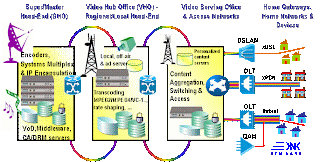The importance of IPTV is set to increase rapidly as cable operators migrate services to an all IP network and DSL service providers enhance their content capability. Service providers deploying IPTV, including AT&T and Verizon. For TV and VoD services, IPTV enables operators to consolidate network infrastructure, improve access bandwidth usage efficiency, and offer enhanced service features such as interactive programming guides (IPGs) and network-based digital video recording (DVR). IPTV can then be offered and billed as part of multi-service packages without radical changes to the customer care and billing platforms.

IPTV involves the interfaces between the service-providers and network providers, as well as both Web-based and IP Multi-media Subsystem (IMS)-based approaches for added functionality.
The playback of IPTV requires either a personal computer or a set-top box connected to a TV. Video content is typically compressed using either a MPEG-2 or a MPEG-4 codec and then sent in an MPEG transport stream delivered via IP Multicast in case of live TV or via IP Unicast in case of Video on Demand. IP Multicast is a method in which information can be sent to multiple computers at the same time. The newly released (MPEG-4) H.264 codec is increasingly used to replace the older MPEG-2 codec.
In standards-based IPTV systems, the primary underlying protocols used for:
Live TV is using IGMP version 2 for connecting to a multicast stream (TV channel) and for changing from one multicast stream to another (TV channel change).
VOD is using the Real Time Streaming Protocol (RTSP).
Currently, the only alternatives to IPTV are traditional TV distribution technologies such as terrestrial, satellite and cable. However, cable can be upgraded to two-way capability and can thus also carry IPTV.
NPVR (network-based Private Video Recorder)
Network Personal Video Recording is a consumer service where real-time broadcast television is captured in the network on a server allowing the end user to access the recorded programs on the schedule of their choice, rather than being tied to the broadcast schedule. The NPVR system provides ultimate time-shifted viewing of broadcast programs, allowing subscribers to record and watch programs at their convenience, without the added expense and maintenance needed for a hard drive-equipped set-top box. It's like having a PVR built into the network. In this way, services usually provided by popular consumer electronics hardware can be offered as network services. Subscribers can watch what they want, when they want, without needing yet another device or remote control.
No comments:
Post a Comment